Characteristics of Flow over Rectangular Labyrinth Weirs with Round Corners
Abstract
1. Introduction
2. Materials and Methods
3. Results and Discussion
3.1. Hydraulic Performance of the Models
3.2. Effects of Weir Height on the Hydraulic Efficiency
3.3. Effects of Weir Length on the Hydraulic Efficiency
3.4. Regression Analysis
4. Conclusions
- For round-cornered rectangular labyrinth weirs, the discharge coefficient, CL, increases as the HT/P ratios increase until a certain value of HT/P is reached, after which CL values decrease steadily;
- Round-cornered rectangular labyrinth weirs with greater LC/B ratios (higher M values) showed higher hydraulic efficiency for the HT/P ranges utilized in this study, 0.1 ≤ HT/P ≤ 0.65. The discharge coefficient increased by 35.7 percent on average as the effective length increased by 57 percent. On average, the discharge coefficient increased by 70% while the effective length increased by 113 percent;
- As the weir height (P) increases, the hydraulic efficiency of round-cornered rectangular labyrinth weirs increases marginally. For the effective length of the weir to the channel width ratios (LC/B) ≤ 1.78, however, the influence of weir height diminishes;
- One should increase the weir height or effective length to lessen the influence of headwater inflation and nappe interferences of flows across round-cornered rectangular labyrinth weirs;
- Using multiple linear regression analysis, a satisfactory correlation equation was found between discharge coefficients of round-cornered rectangular labyrinth weirs, CB, and the other parameters, namely the effective length (LC), weir height (P), and water depth over the weir crest (h).
Author Contributions
Funding
Institutional Review Board Statement
Informed Consent Statement
Data Availability Statement
Acknowledgments
Conflicts of Interest
References
- Bilhan, O.; Emiroglu, M.; Miller, C. Experimental Investigation of Discharge Capacity of Labyrinth Weirs with and without Nappe Breakers. World J. Mech. 2016, 6, 207–221. [Google Scholar] [CrossRef][Green Version]
- Crookston, B.M.; Tullis, B.P. Labyrinth weirs: Nappe interference and local submergence. J. Irrig. Drain Eng. 2012, 138, 757–765. [Google Scholar] [CrossRef]
- Tullis, P.; Amanian, N.; Waldron, D. Design of labyrinth spillways. J. Hydraul. Eng. 1995, 121, 247–255. [Google Scholar] [CrossRef]
- Taylor, G. The Performance of Labyrinth Weirs. Ph.D. Thesis, University of Nottingham, Nottingham, UK, 1968. [Google Scholar]
- Azimi, A.H.; Hakim, S.S. Hydraulics of flow over rectangular labyrinth weirs. Irrig. Sci. 2019, 37, 183–193. [Google Scholar] [CrossRef]
- Jansen, R.B. Advanced dam Engineering for Design, Construction, and Rehabilitation; Springer Science & Business Media: Berlin/Heidelberg, Germany, 1988. [Google Scholar]
- Safarrazavi Zadeh, M.; Esmaeili Varaki, M.; Biabani, R. Experimental study on flow over sinusoidal and semicircular labyrinth weirs. ISH J. Hydraul. Eng. 2019, 1–10. [Google Scholar] [CrossRef]
- Crookston, B.M. Labyrinth Weirs. Ph.D. Dissertation, Utah State University, Logan, UT, USA, 2010. [Google Scholar]
- Anderson, R.M.; Tullis, B.P. Comparison of piano key and rectangular labyrinth weir hydraulics. J. Hydraul. Eng. 2012, 138, 358–361. [Google Scholar] [CrossRef]
- Kabiri-Samani, A.; Javaheri, A.; Borghei, S.M. Discharge coefficient of a rectangular labyrinth weir. ICE’s Water Manag. 2013, 166, 443–451. [Google Scholar] [CrossRef]
- Henderson, F.M. Open Channel Flow (No. 532 H4); Macmillan: New York, NY, USA, 1966. [Google Scholar]
- Rostami, H.; Heidarnejad, M.; Purmohammadi, M.H.; Kamanbedast, A.; Bordbr, A. An Experimental study into discharge coefficient of labyrinth weirs with rectangular-shaped plans. Fresen. Environ. Bull. 2016, 25, 5138–5144. [Google Scholar]
- Emadi, A.R.; Rezaei, M. Experimental study of rectangular labyrinth weirs. J. Water Soil (Agric. Sci. Technol.) 2015, 29, 1438–1446. [Google Scholar]
- Heidarour, M.; Mousavi, S.F.; Zarmehri, A.R. Investigation of rectangular and U-shaped labyrinth weirs. JWSS-Isfahan Univ. Technol. 2006, 10, 519–531. [Google Scholar]
- Yousif, O.S.; Karakouzian, M. Effect of Corner Shape on Hydraulic Performance of One-Cycle Rectangular Labyrinth Weirs. Fluids 2020, 5, 117. [Google Scholar] [CrossRef]


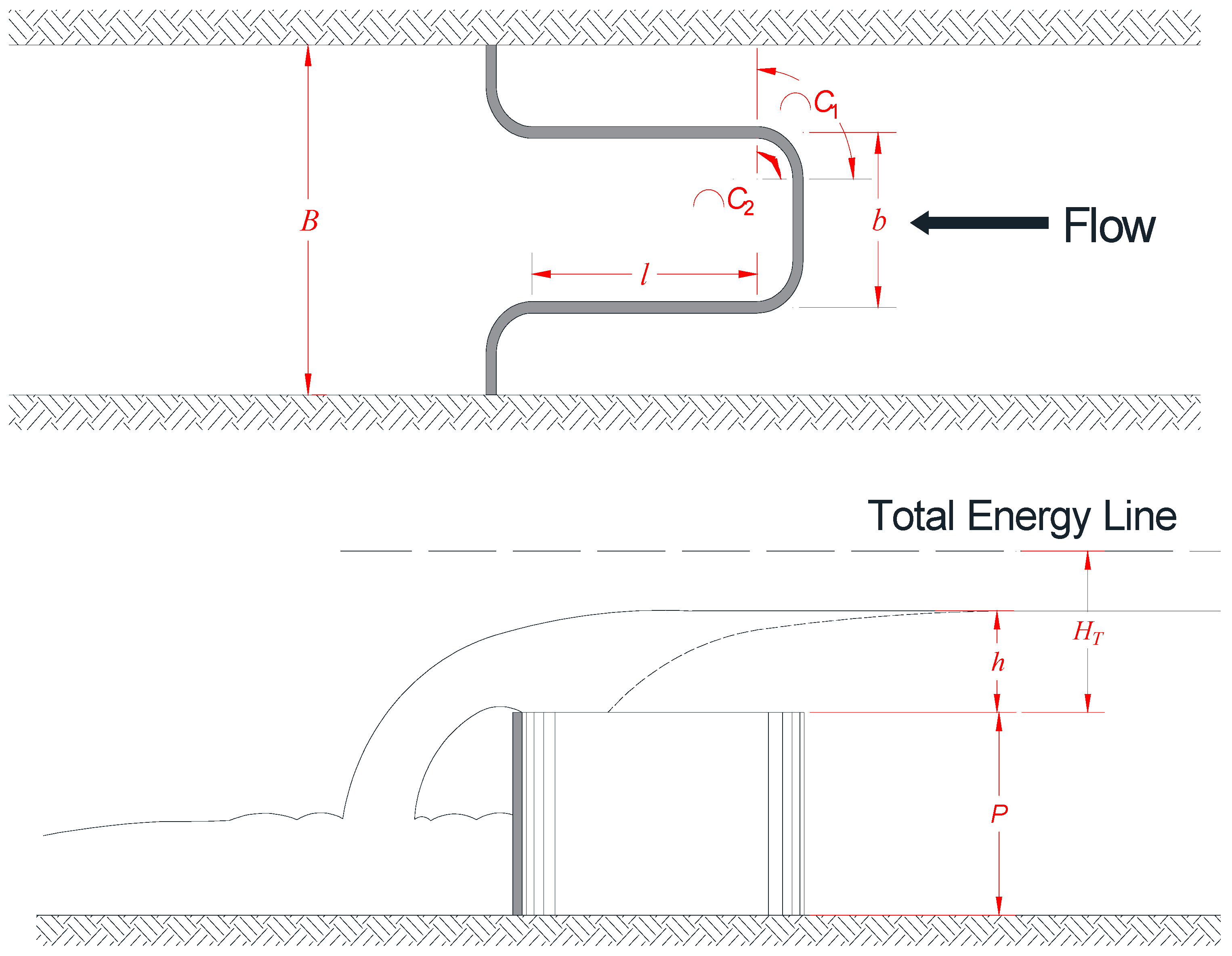
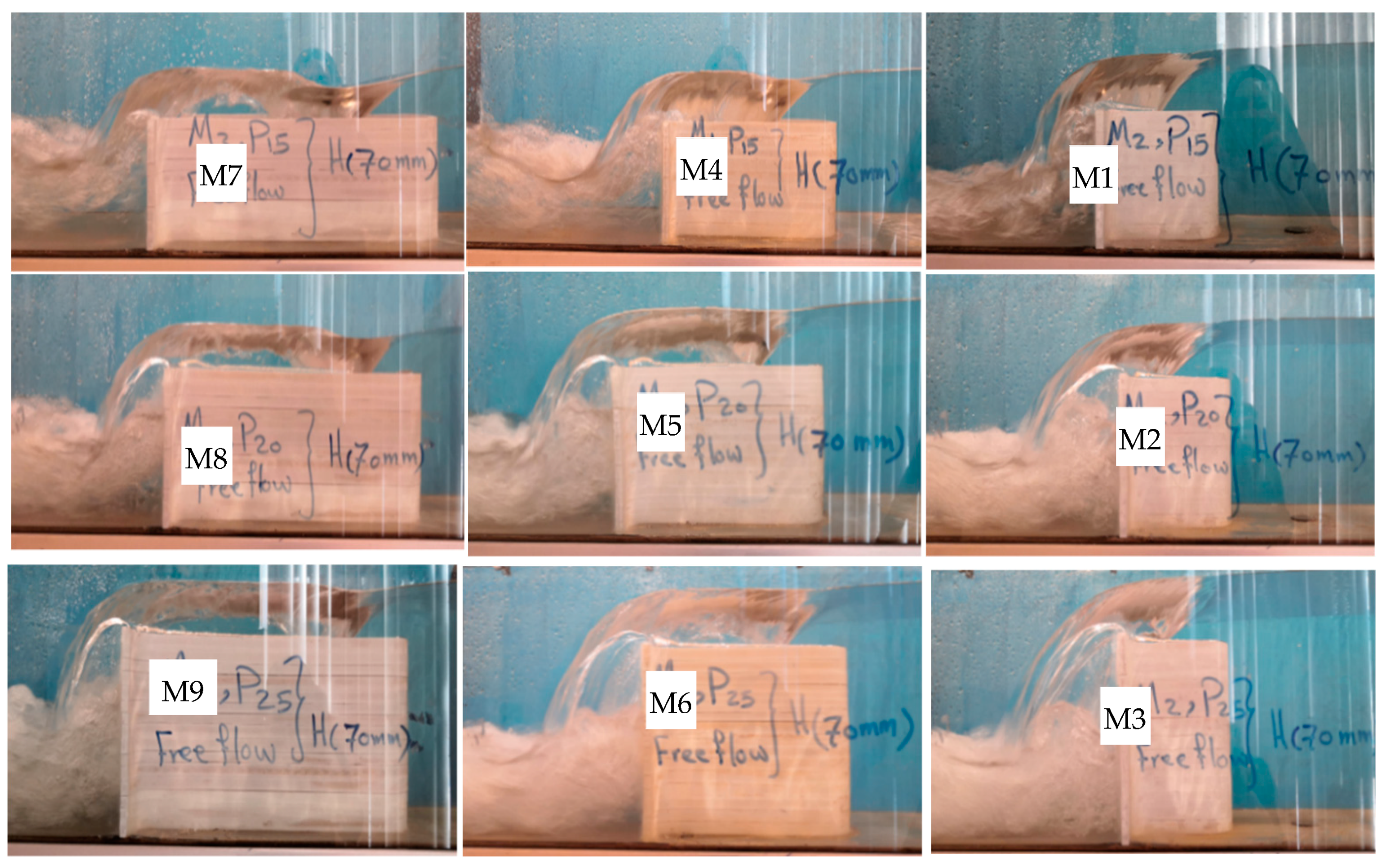
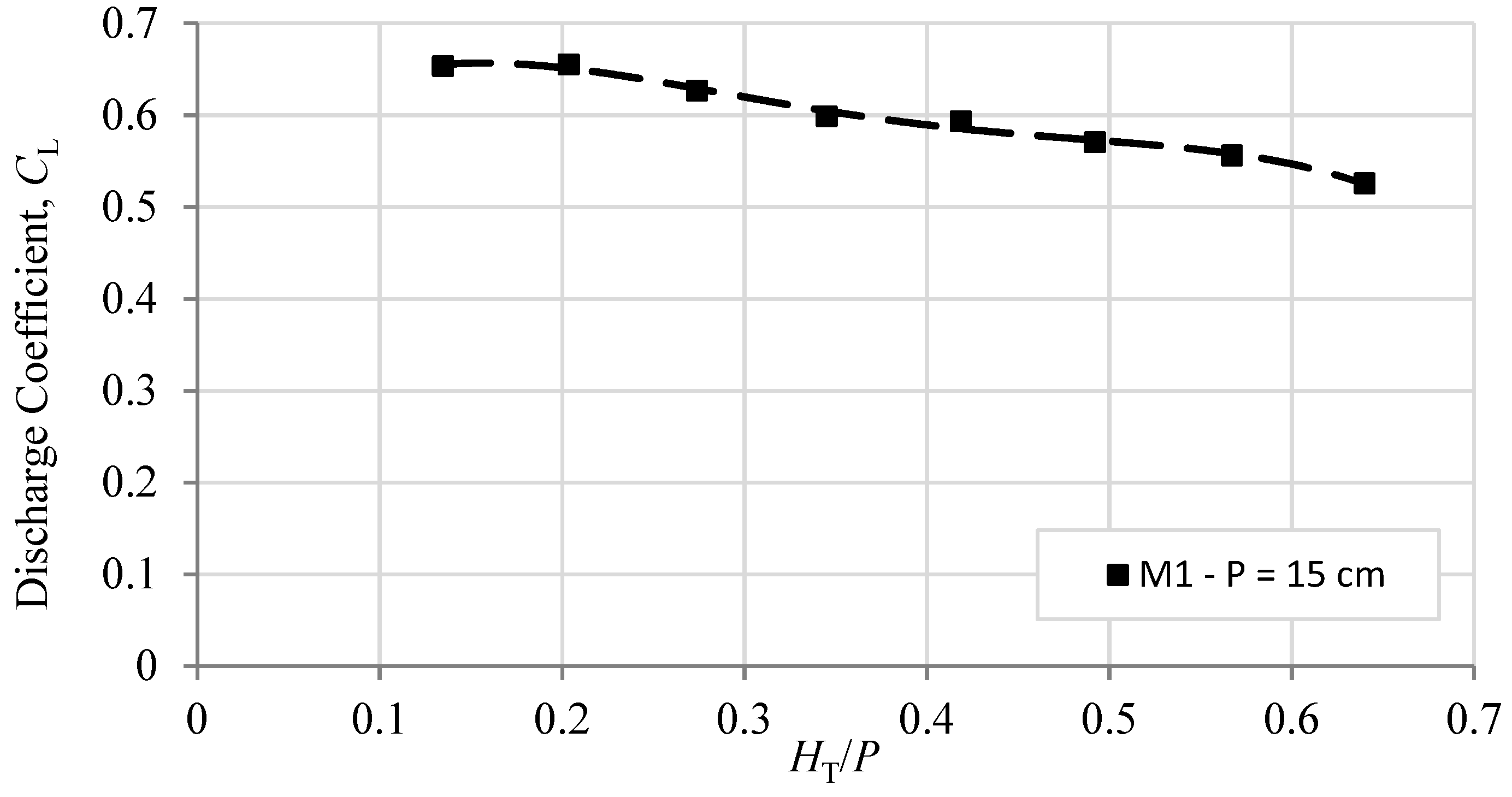

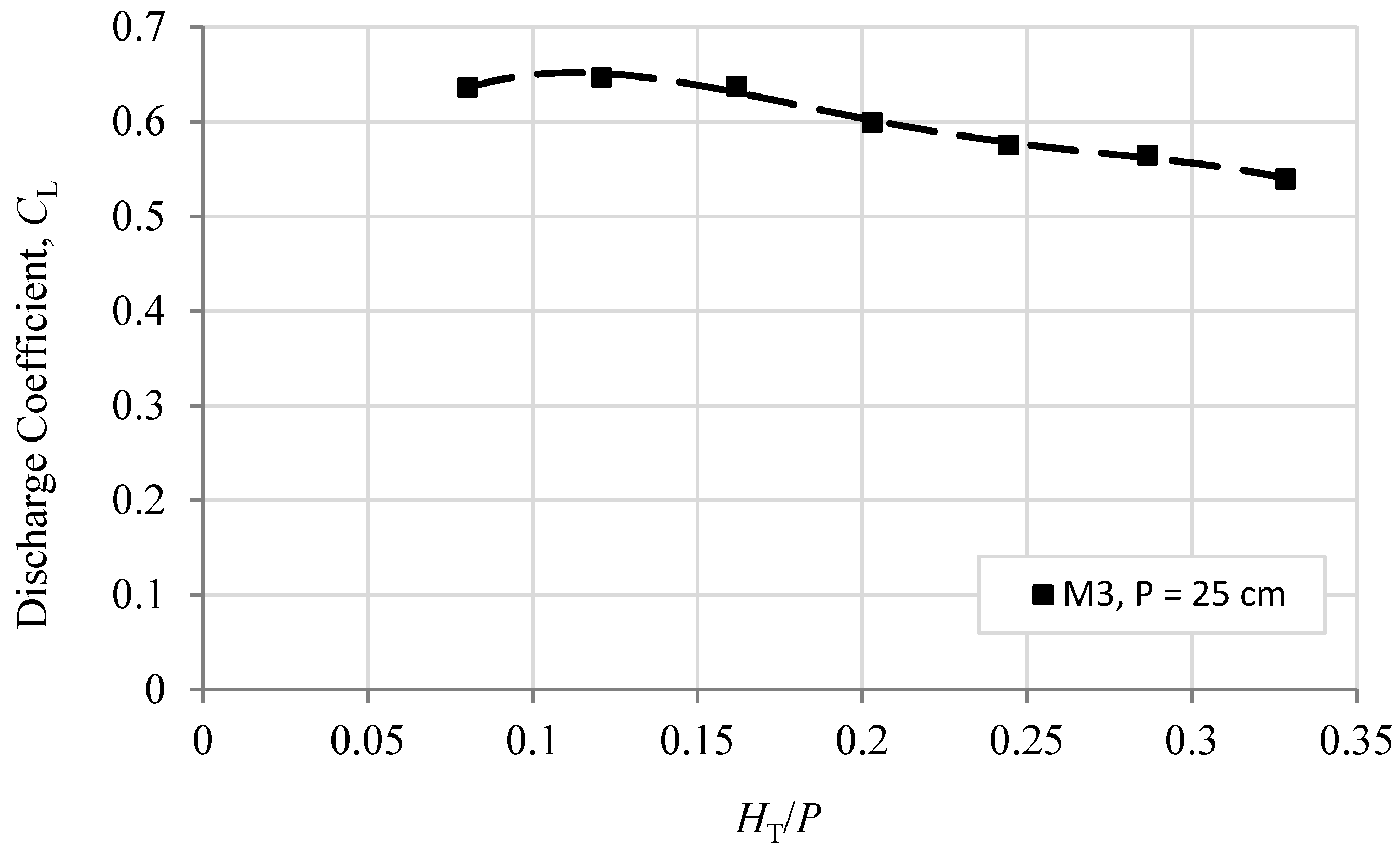
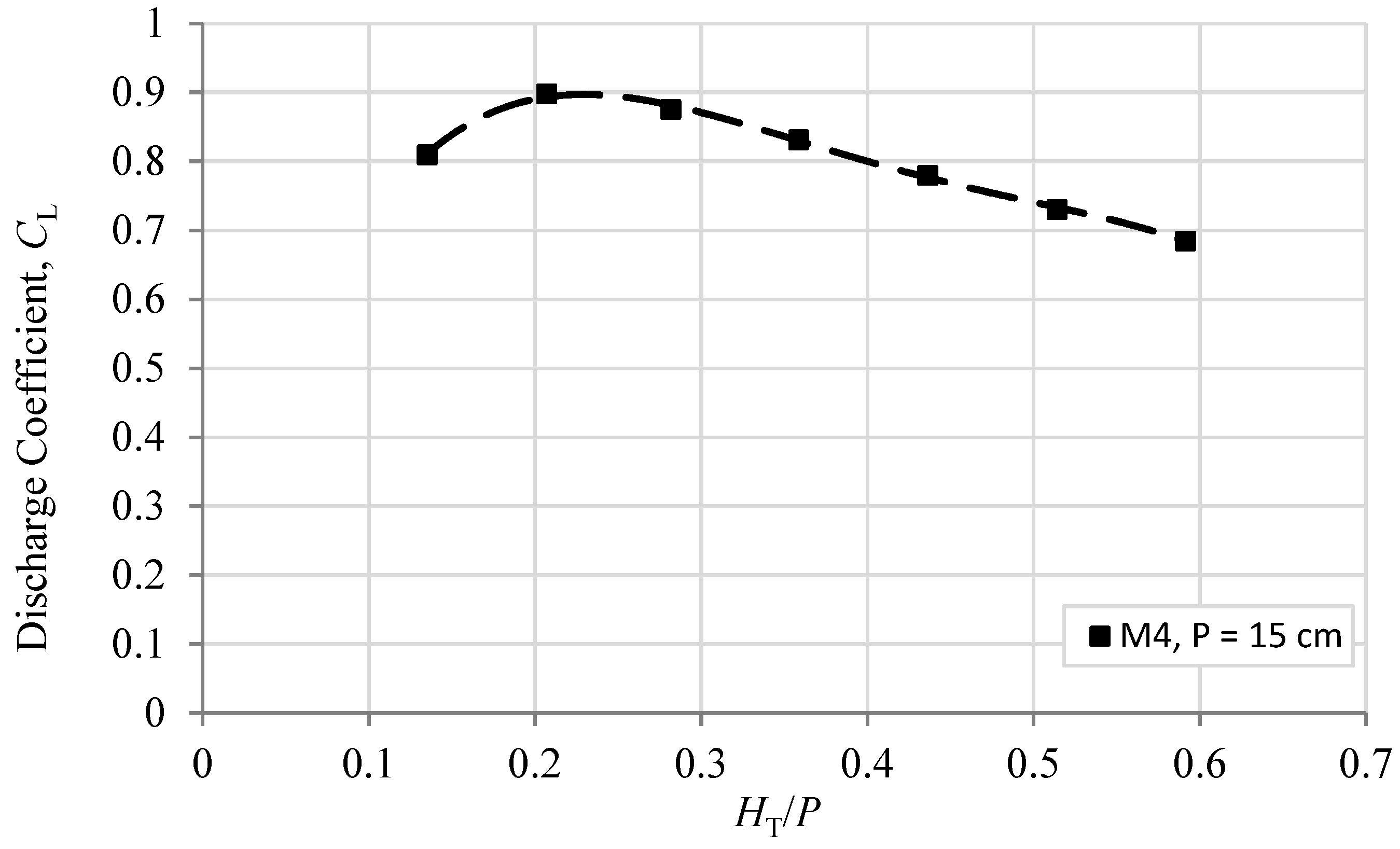
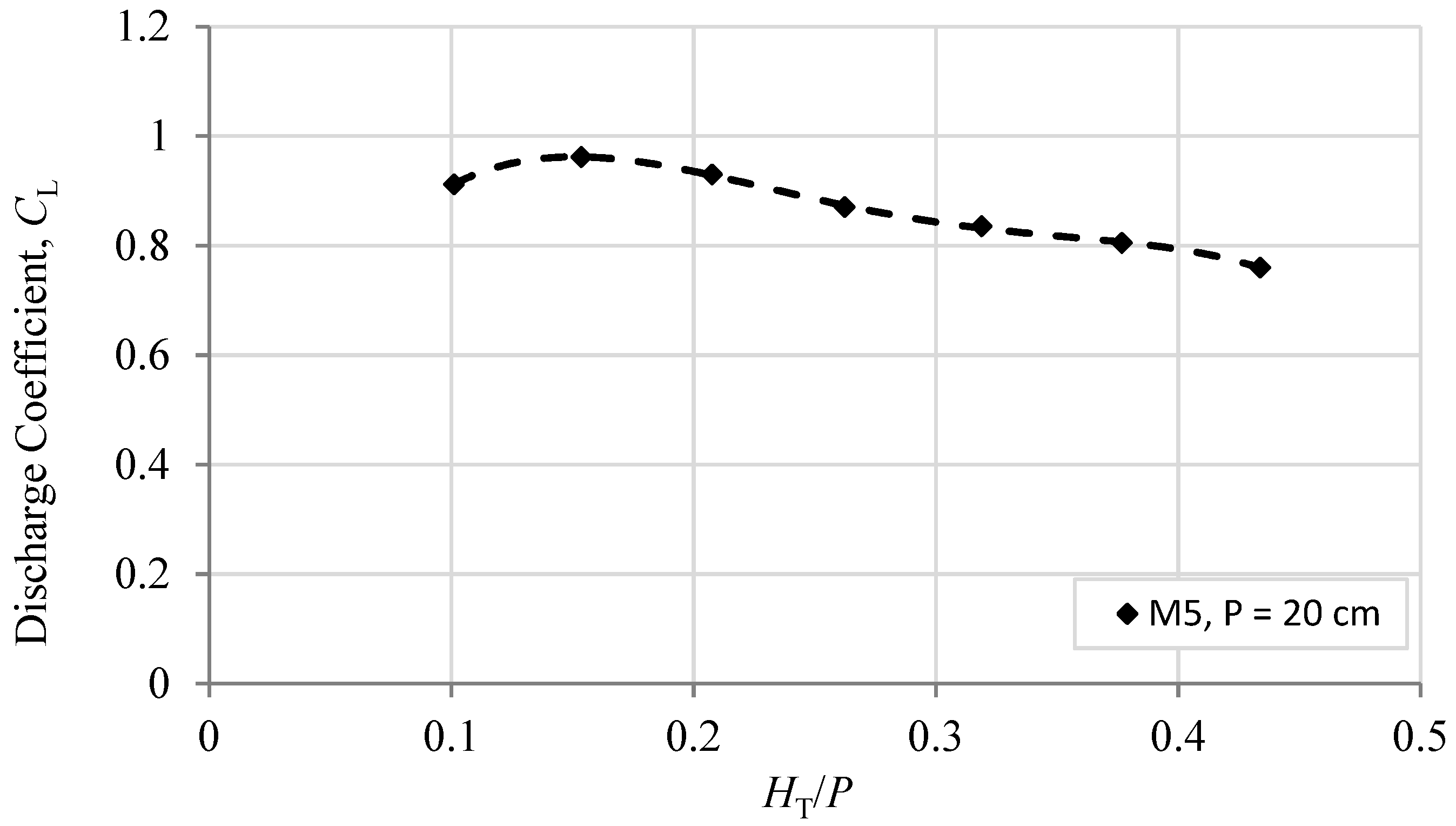
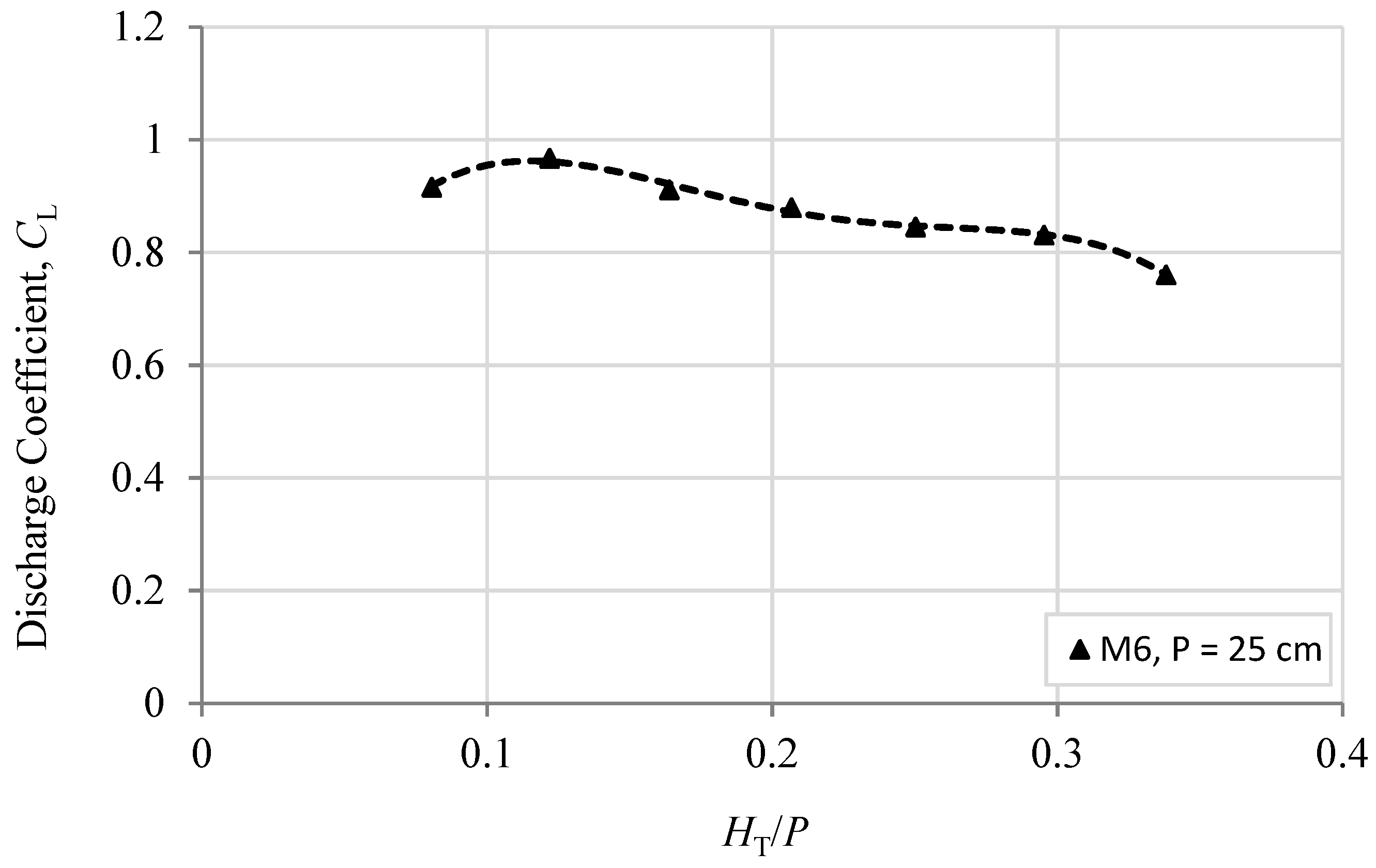
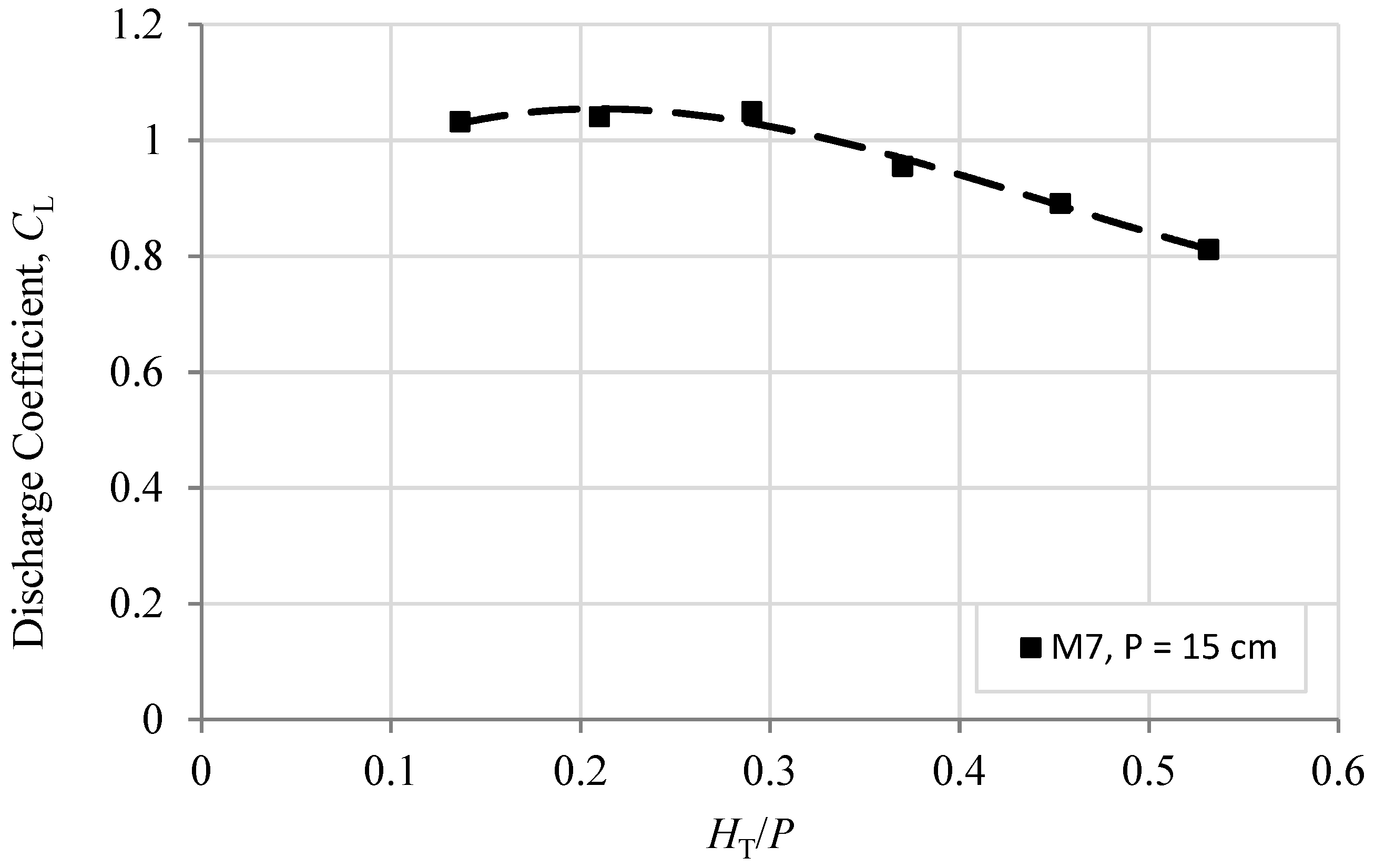
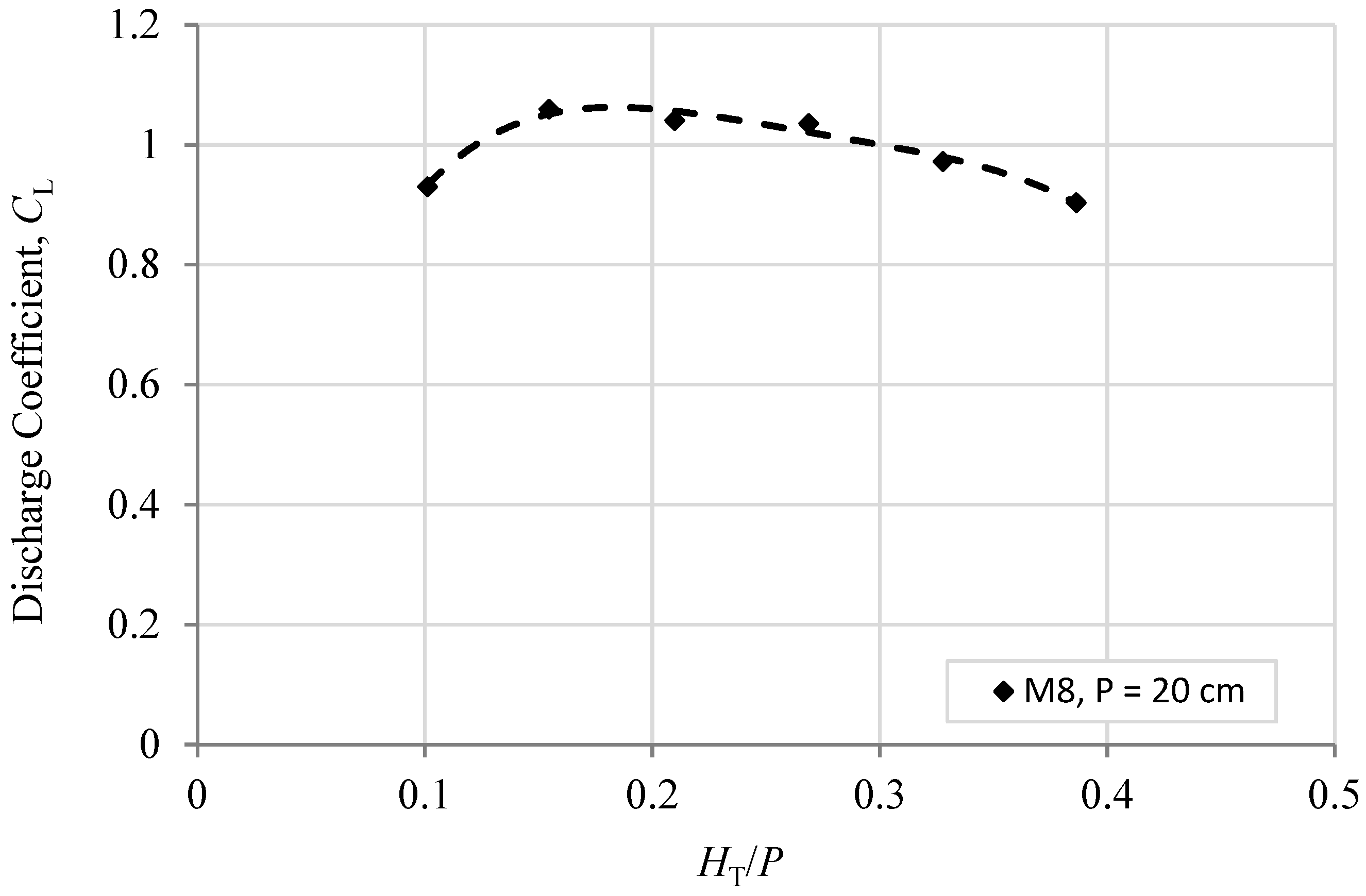


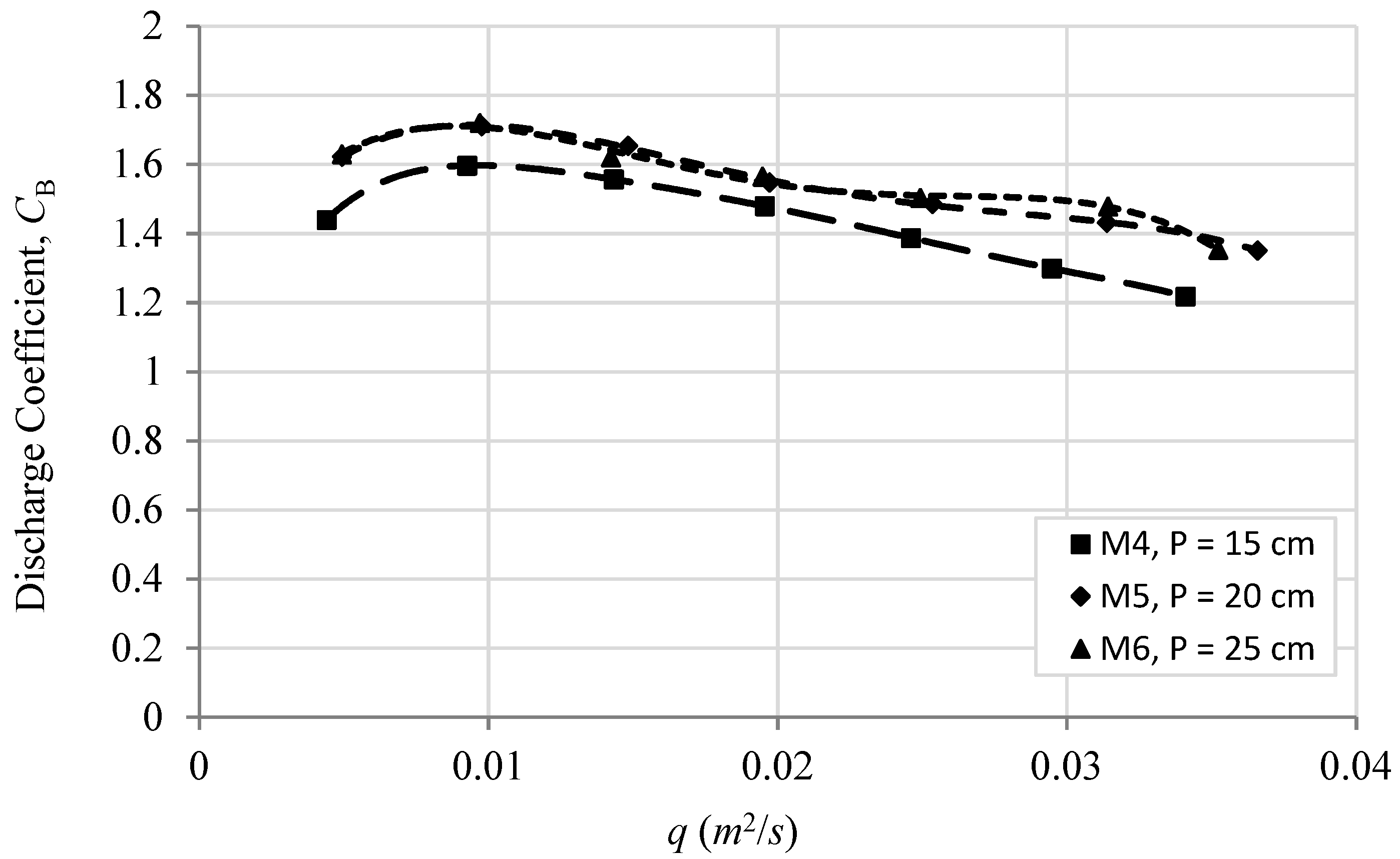

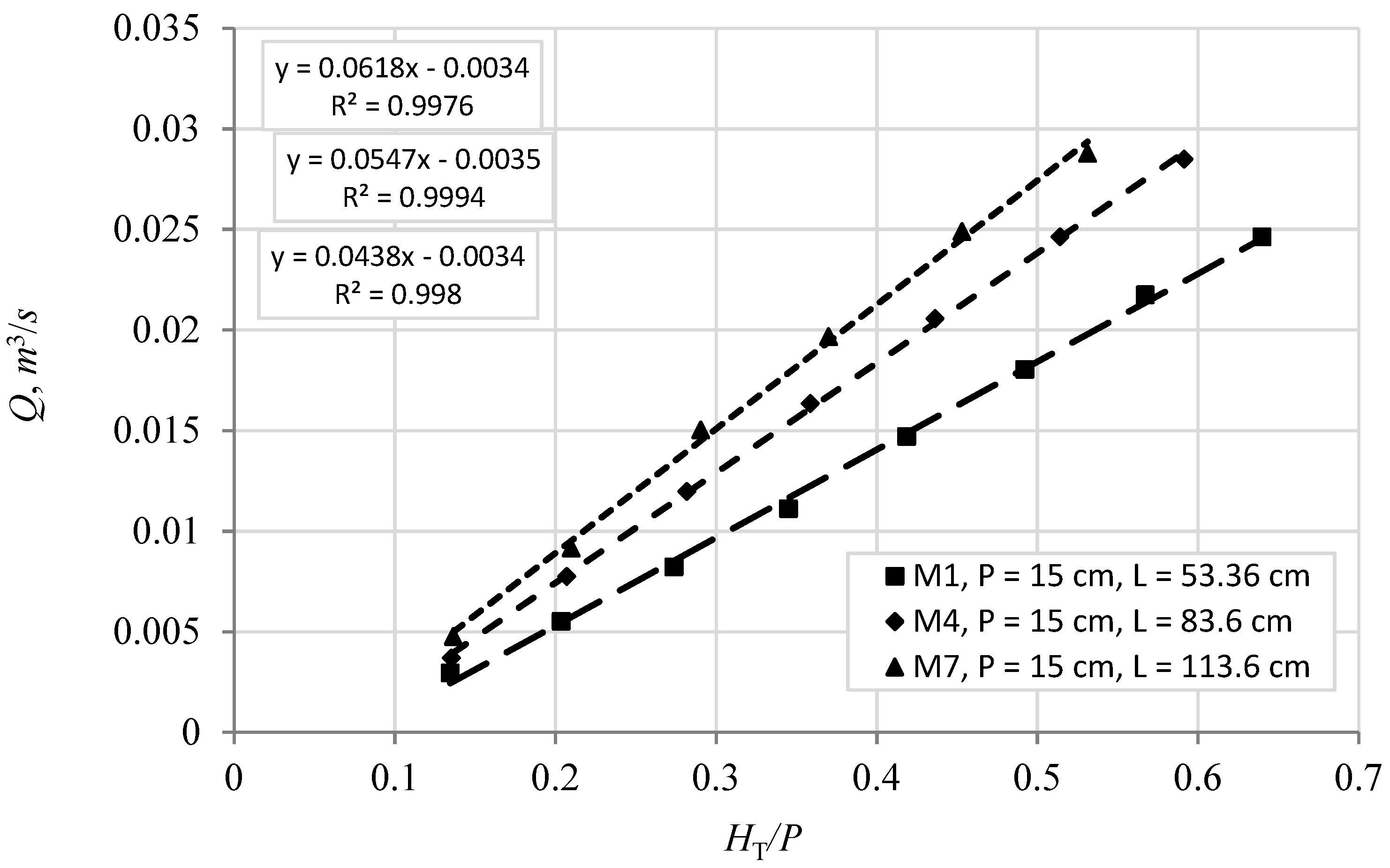

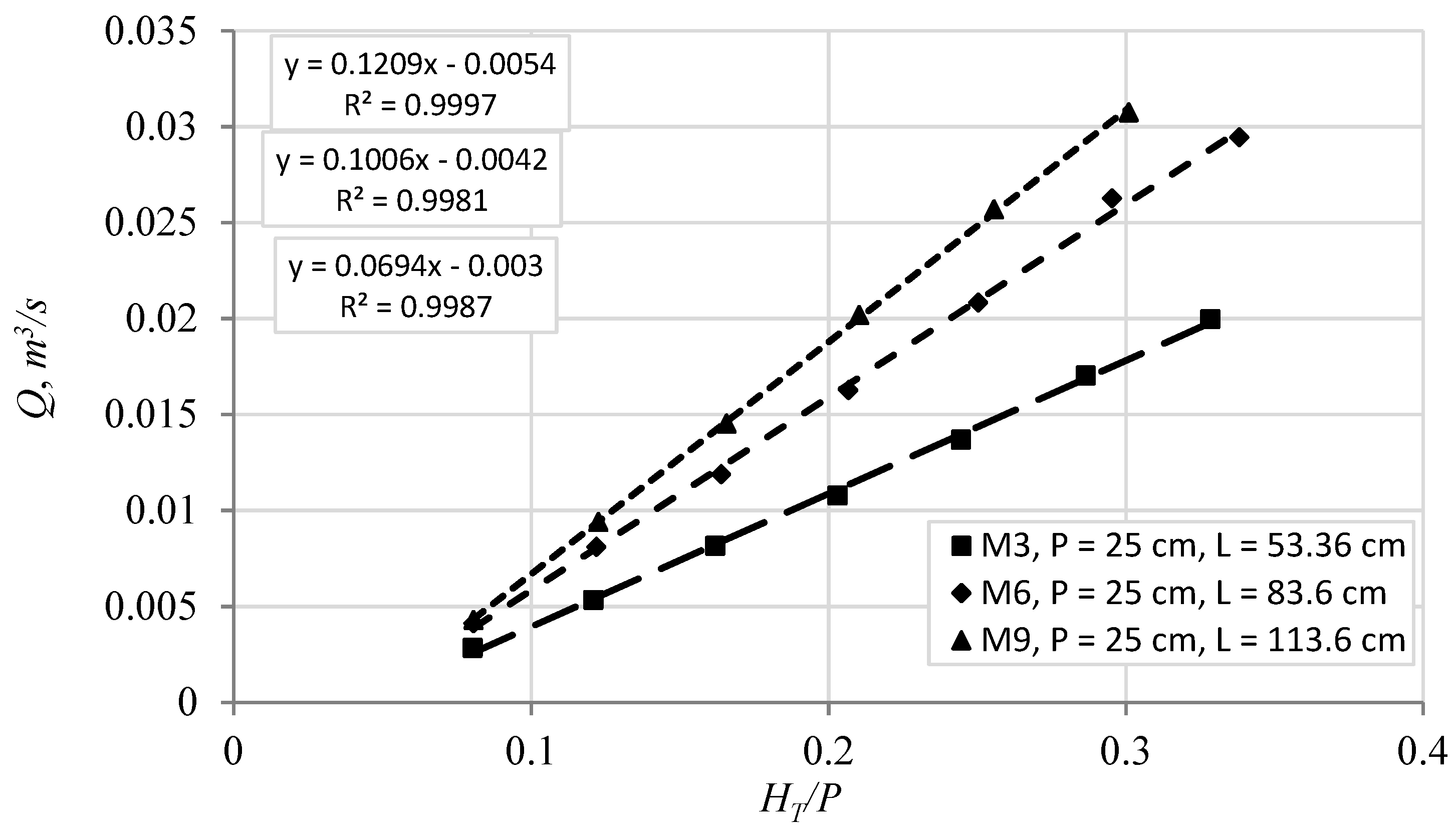
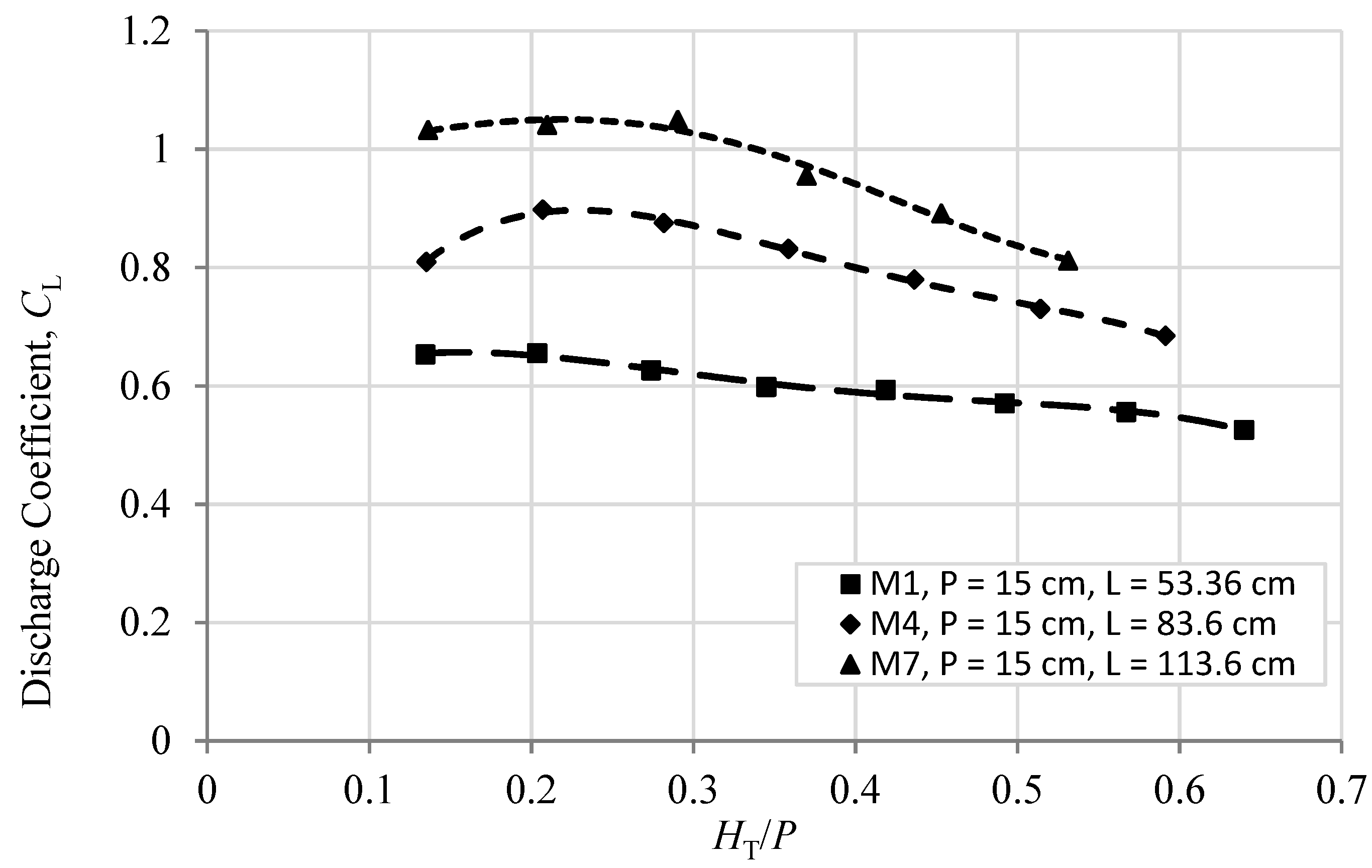


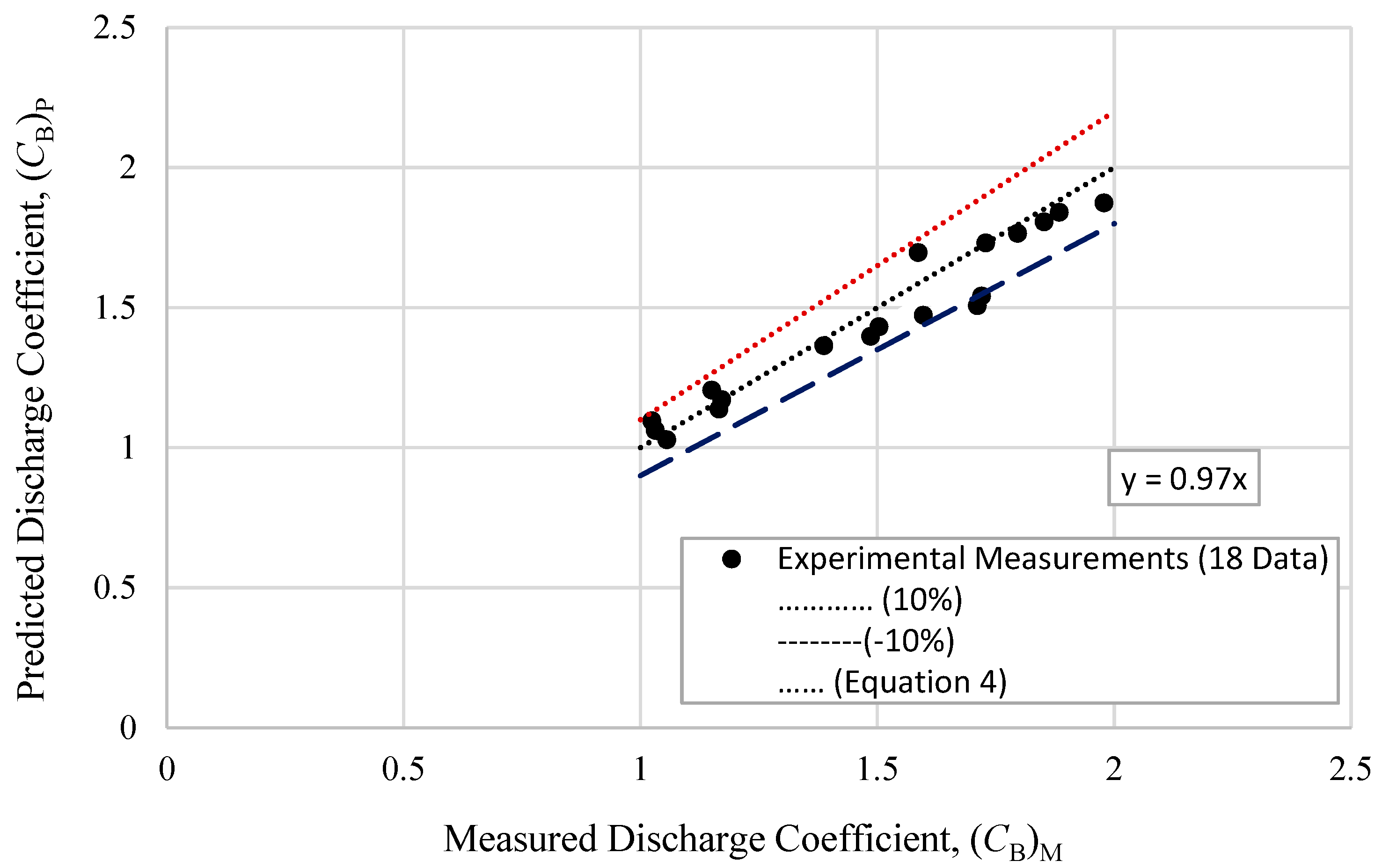
| Model | B (mm) | b (mm) | l (mm) | t (mm) | C1 (mm) | C2 (mm) | P (mm) | LC * (mm) | LC/B | B/P |
|---|---|---|---|---|---|---|---|---|---|---|
| M1 | 300 | 150 | 75 | 10 | 42.5 | 32.5 | 150 | 533.6 | 1.78 | 2.0 |
| M2 | 300 | 150 | 75 | 10 | 42.5 | 32.5 | 200 | 533.6 | 1.78 | 1.5 |
| M3 | 300 | 150 | 75 | 10 | 42.5 | 32.5 | 250 | 533.6 | 1.78 | 1.2 |
| M4 | 300 | 150 | 225 | 10 | 42.5 | 32.5 | 200 | 836 | 2.79 | 2.0 |
| M5 | 300 | 150 | 225 | 10 | 42.5 | 32.5 | 200 | 836 | 2.79 | 1.5 |
| M6 | 300 | 150 | 225 | 10 | 42.5 | 32.5 | 200 | 836 | 2.79 | 1.2 |
| M7 | 300 | 150 | 375 | 10 | 42.5 | 32.5 | 250 | 1136 | 3.79 | 2.0 |
| M8 | 300 | 150 | 375 | 10 | 42.5 | 32.5 | 250 | 1136 | 3.79 | 1.5 |
| M9 | 300 | 150 | 375 | 10 | 42.5 | 32.5 | 250 | 1136 | 3.79 | 1.2 |
| Model | Q, m3/s | h, m | (HT/P) * |
|---|---|---|---|
| M1 | 0.00295–0.0246 | 0.02–0.09 | 0.1345–0.639 |
| M2 | 0.00296–0.0239 | 0.02–0.09 | 0.1005–0.4693 |
| M3 | 0.00285–0.0199 | 0.02–0.08 | 0.0803–0.3283 |
| M4 | 0.00368–0.0285 | 0.02–0.08 | 0.1351–0.5913 |
| M5 | 0.00412–0.0305 | 0.02–0.08 | 0.101–0.4338 |
| M6 | 0.00412–0.0294 | 0.02–0.08 | 0.805–0.338 |
| M7 | 0.00475–0.0287 | 0.02–0.07 | 0.1363–0.5313 |
| M8 | 0.00421–0.0305 | 0.02–0.07 | 0.101–0.3863 |
| M9 | 0.00429–0.0307 | 0.02–0.07 | 0.0806–0.3009 |
| Model | a0 | a1 | a2 | a3 | a4 | R2 |
|---|---|---|---|---|---|---|
| M1 | 0.5257 | 2.0505 | −10.48 | 19.409 | −12.566 | 0.991 |
| M2 | 0.5953 | 1.1898 | −6.202 | 6.8072 | 0.7842 | 0.9954 |
| M3 | 0.3328 | 7.3478 | −57.45 | 176 | −192.84 | 0.992 |
| M4 | 0.1188 | 9.0016 | −35.874 | 57.483 | −33.527 | 0.9975 |
| M5 | 0.2301 | 12.801 | −76.787 | 183.44 | −156.7 | 0.9992 |
| M6 | 0.1195 | 19.614 | −158.05 | 513.9 | −595.85 | 0.9926 |
| M7 | 0.9729 | 0.119 | 4.778 | −21.419 | 20.596 | 0.9839 |
| M8 | −0.0711 | 17.962 | −102.55 | 251.25 | −231.1 | 0.9728 |
| M9 | −0.5141 | 33.727 | −249.88 | 786.4 | 913.58 | 0.9924 |
| Parameters | Percentage Changes | |||
|---|---|---|---|---|
| M5/M4 | M6/M4 | M8/M7 | M9/M7 | |
| Weir Length to Channel Width ratios, LC/B | 2.79 | 2.79 | 3.79 | 3.79 |
| Coefficient of Discharge (CB) | 5.3–12 | 4.45–13.5 | 0.0–13.6 | 0.0–18 |
| (8.8) * | (9.4) * | (4.3) * | (8.3) * | |
| Parameters | Percentage Changes | |||||
|---|---|---|---|---|---|---|
| M4/M1 | M7/M1 | M5/M2 | M8/M2 | M6/M3 | M9/M3 | |
| Length ratios LC/LC | 1.567 | 2.129 | 1.567 | 2.129 | 1.567 | 2.129 |
| Total Discharge (Q) | 28.5–48.4 | 47.8–85.2 | 55–44 | 62.1–66.4 | 48–70.9 | 76–89.7 |
| (33.6) * | (57.5) * | (46.9) * | (65.3) * | (53.7) * | (79.5) * | |
| Coefficient of Discharge (CL) | 26.8–40.5 | 43–65.7 | 38.1–46.7 | 62.3–96.3 | 44.2–48.8 | 49.6–77.1 |
| (34.2) * | (57.2) * | (44.2) * | (84.7) * | (46.6) * | (69.1) * | |
Publisher’s Note: MDPI stays neutral with regard to jurisdictional claims in published maps and institutional affiliations. |
© 2021 by the authors. Licensee MDPI, Basel, Switzerland. This article is an open access article distributed under the terms and conditions of the Creative Commons Attribution (CC BY) license (https://creativecommons.org/licenses/by/4.0/).
Share and Cite
Yousif, O.S.Q.; Abdulrahman, K.Z.; Qadir, W.; Ali, A.S.; Karakouzian, M. Characteristics of Flow over Rectangular Labyrinth Weirs with Round Corners. Hydrology 2021, 8, 158. https://doi.org/10.3390/hydrology8040158
Yousif OSQ, Abdulrahman KZ, Qadir W, Ali AS, Karakouzian M. Characteristics of Flow over Rectangular Labyrinth Weirs with Round Corners. Hydrology. 2021; 8(4):158. https://doi.org/10.3390/hydrology8040158
Chicago/Turabian StyleYousif, Omed S. Q., Kawa Z. Abdulrahman, Wazira Qadir, Ahang S. Ali, and Moses Karakouzian. 2021. "Characteristics of Flow over Rectangular Labyrinth Weirs with Round Corners" Hydrology 8, no. 4: 158. https://doi.org/10.3390/hydrology8040158
APA StyleYousif, O. S. Q., Abdulrahman, K. Z., Qadir, W., Ali, A. S., & Karakouzian, M. (2021). Characteristics of Flow over Rectangular Labyrinth Weirs with Round Corners. Hydrology, 8(4), 158. https://doi.org/10.3390/hydrology8040158







